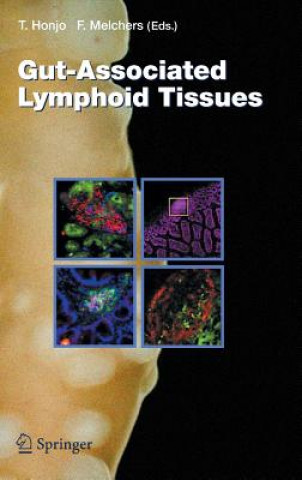
Kod: 01561464
Gut-Associated Lymphoid Tissues
Autor Tasuku Honjo, Fritz Melchers
The intestine is the front line of the confrontation between pathogens and the immune system. However, it is also important to emphasize that we have a symbiotic relationship with innumerable bacteria in the intestine. In the gast ... więcej
- Język:
 Angielski
Angielski - Oprawa: Twarda
- Liczba stron: 210
Wydawca: Springer-Verlag Berlin and Heidelberg GmbH & Co. KG, 2006
- Więcej informacji o książce

881.46 zł

Dostępna u dostawcy w małych ilościach
Wysyłamy za 12 - 15 dni
Potrzebujesz więcej egzemplarzy?Jeżeli jesteś zainteresowany zakupem większej ilości egzemplarzy, skontaktuj się z nami, aby sprawdzić ich dostępność.
Dodaj do schowka
Zobacz książki o podobnej tematyce
-

No Humans Involved
47.71 zł -23 % -

Knitters Handy Book Of Patterns
100.51 zł -11 % -

Astadala Yogamala Vol.3 the Collected Works of B.K.S Iyengar
133.01 zł -9 % -

Impact of the Social Sciences
393.97 zł -10 %
Bon podarunkowy: Radość gwarantowana
- Podaruj bon o dowolnej wartości, a my się zajmiemy resztą.
- Bon podarunkowy dotyczy całej naszej oferty.
- Możesz wydrukować elektroniczny bon z e-maila a następnie przekazać go obdarowanemu.
- Ważność bonu wynosi 12 miesięcy od daty wystawienia.
Więcej informacji o Gut-Associated Lymphoid Tissues
Za ten zakup dostaniesz 509 punkty
 Opis
Opis
The intestine is the front line of the confrontation between pathogens and the immune system. However, it is also important to emphasize that we have a symbiotic relationship with innumerable bacteria in the intestine. In the gastrointestinal tract of mammals the lower intestine harbors around 1,000 12 species of anaerobic and aerobic bacteria, in densities up to 10 /mlinthe distal small intestine, the cecum, and the colon. A single layer of epithelial cells of the intestine protects the internal organs of the mammalian host from these bacteria. Below these epithelial cells the gut-associated lymphoid tissues (GALT), organized in Peyer s patches, cryptopatches, and isolated l- phoid follicles, as well as isolated, dispersed single cells in the epithelial layer (intraepithelial lymphocytes) and lamina propria, are composed of T l- phocytes, B lymphocytes, Ig-secreting plasma cells, and antigen-presenting cells such as dendritic cells. The importance of the gut barrier is striking, if we consider that in humans the epithelial surface, behind which the immune system faces and senses the endogenous bacteria, is estimated to be as large as a basketball court. Perhaps not surprising then, the gut contains appr- imately half of all lymphocytes of our immune system. Colonization of the intestine with the ?ora of commensal bacteria induces the development of the GALT, which in turn responds by the development of IgA-secreting plasma cells. Dimeric and multimeric IgAs can traverse the epithelial layer and are released in the gut lumen, where they bind bacteria.
 Szczegóły książki
Szczegóły książki
Kategoria Książki po angielsku Medicine Clinical & internal medicine Diseases & disorders
881.46 zł
- Pełny tytuł: Gut-Associated Lymphoid Tissues
- Autor: Tasuku Honjo, Fritz Melchers
- Język:
 Angielski
Angielski - Oprawa: Twarda
- Liczba stron: 210
- EAN: 9783540306566
- ISBN: 3540306560
- ID: 01561464
- Wydawca: Springer-Verlag Berlin and Heidelberg GmbH & Co. KG
- Waga: 1090 g
- Wymiary: 235 × 155 × 13 mm
- Data wydania: 10. July 2006
Ulubione w innej kategorii
-

Healing Add
79.90 zł -13 % -

Radical Remission
76.14 zł -13 % -

Cancer as a Metabolic Disease - On the Origin, Management, and Prevention of Cancer
766.01 zł -

Palliative Radiation Oncology
1234.31 zł -

Roitt's Essential Immunology 13e
292.73 zł -

Infectious Diseases: A Clinical Short Course
455.30 zł -

CT Anatomy for Radiotherapy
413.26 zł -

Bethesda Handbook of Clinical Oncology
346.75 zł -3 % -

How to Starve Cancer
108.33 zł -6 % -

Comprehensive Review of Infectious Diseases
582.83 zł -8 % -

Spillover
54.01 zł -10 % -

Healing Lyme Disease Coinfections
82.74 zł -8 % -

Allergic to Life
186.01 zł -5 % -

Cardio-Oncology
484.84 zł -

Immunology Guidebook
1193.49 zł -

Schaum's Outline of Immunology
130.77 zł -5 % -

Emperor of All Maladies
58.17 zł -15 % -

Natural Treatments for Lyme Coinfections
82.74 zł -8 % -

Oxford Handbook of Clinical Immunology and Allergy
160.73 zł -14 % -

Musculoskeletal Imaging
462.20 zł -8 % -

Graphic Guide to Infectious Disease
246.43 zł -

Health and Disease Begin in the Colon
226.32 zł -

Oxford Handbook of Infectious Diseases and Microbiology
212.01 zł -4 % -

TNM Classification of Malignant Tumours 8e
223.68 zł -3 % -

Cancer and the New Biology of Water
104.17 zł -6 % -

Basic Immunology
293.14 zł -6 % -

Autoimmune Solution
52.38 zł -23 % -

p53
59.49 zł -20 % -

Lanzkowsky's Manual of Pediatric Hematology and Oncology
951.32 zł -

Principles of Gynecologic Oncology Surgery
1573.76 zł -

Radiation Oncology Management Decisions
516.22 zł -2 % -

Netter's Infectious Diseases
406.96 zł -

Atlas of Multiparametric Prostate MRI
870.19 zł -

Vaccine Race
52.38 zł -23 % -

Complete Guide to Breast Cancer
80.31 zł -23 % -

Color Atlas of Immunology
95.13 zł -8 % -

Compatibility Gene
52.38 zł -23 % -

Key to Self-Liberation
400.36 zł -

Handbook of Breast MRI
435.39 zł -14 % -

Dermatoscopy of Non-Pigmented Skin Tumors
1025.75 zł -

Breast Ultrasound
436.71 zł -

Manson's Tropical Diseases
1292.60 zł -

Abeloff's Clinical Oncology
1961.03 zł -

Clinical Physiology of Acid-Base and Electrolyte Disorders
509.72 zł -

Atlas of Breast Surgery
1292.29 zł -

Cardio-Oncology Practice Manual: A Companion to Braunwald's Heart Disease
714.32 zł -

Illustrated Anatomical Segmentectomy for Lung Cancer
723.46 zł -

Nanomedicine for Cancer Diagnosis and Therapy
1035.60 zł -

Chemotherapy Protocols and Infusion Sequence
484.84 zł
zadowolonych klientów
Od roku 2008 obsłużyliśmy wielu miłośników książek, ale dla nas każdy był tym wyjątkowym.
Copyright! ©2008-24 libristo.pl Wszelkie prawa zastrzeżonePrywatnieCookies


 21 milionów książek
21 milionów książek Dostawa 10.99 zł
Dostawa 10.99 zł (32) 444 93 66 (8-15.30h)
(32) 444 93 66 (8-15.30h)